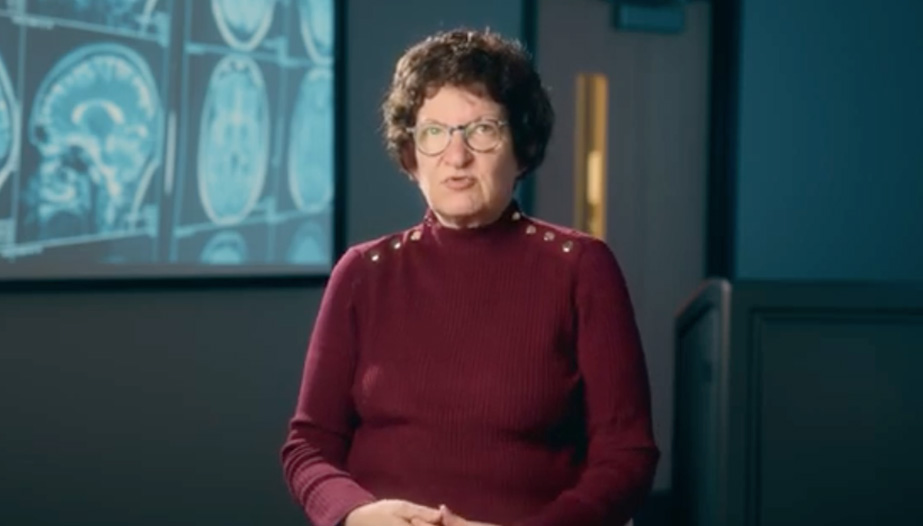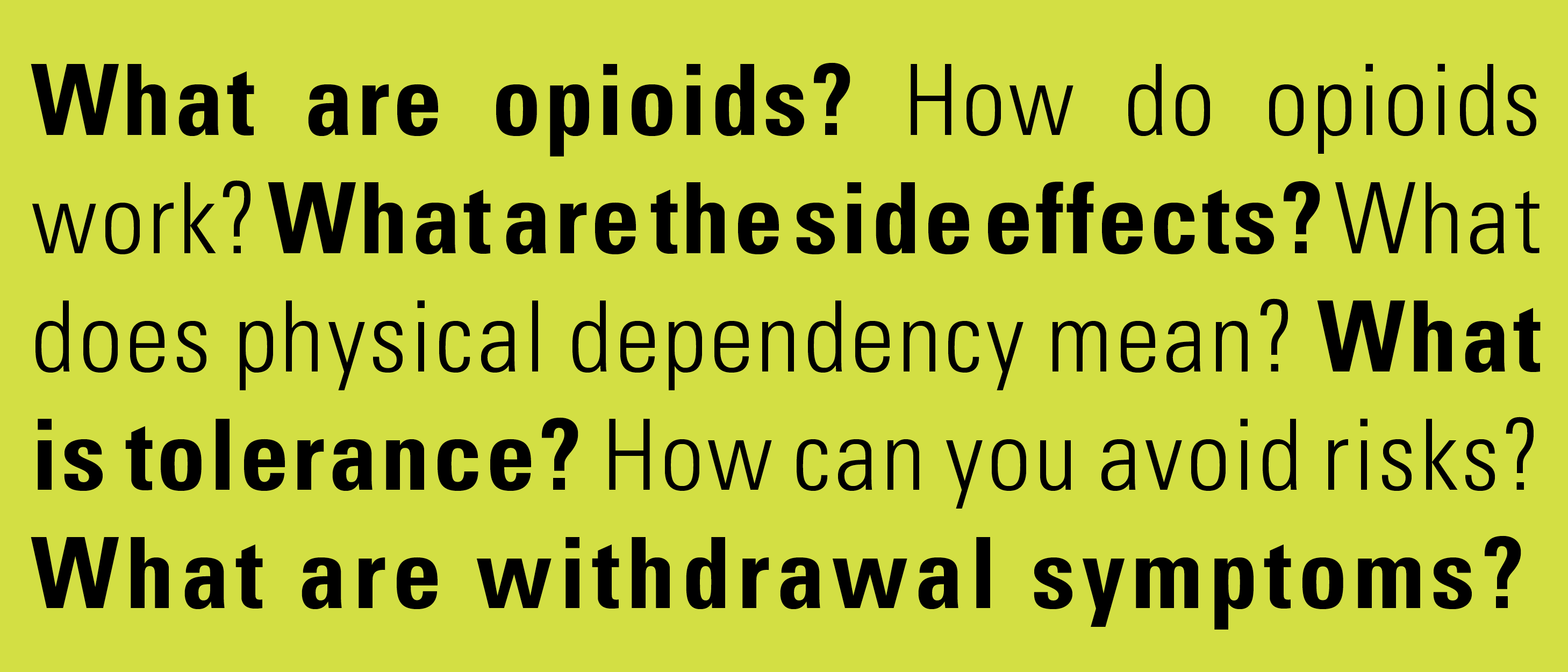Opioid Guideline Education Documents
Informational Patient Videos


WEBSITE
Medical cannabis: A solution for chronic pain?
Dr. Jason Busse talks with the McMaster Optimal Aging Portal


POP-UP
Tame the Beast

Opioid Frequently Asked Questions
Opioid Contract
The opioid contract is an agreement between an individual and their prescriber:
- When an opioid is prescribed by a physician, dentist or nurse practitioner.
- Intended to educate you about the safe use of opioids and clearly outline what may happen if expectations are not met.
- May include terms like keeping scheduled appointments, participating in all aspects of care, using only one prescriber and one pharmacy, and providing random urine samples and random pill counts.
- To prioritize care, safety, and responsibility for both individuals and prescribers.
The opioid contract:
- Lists the terms you and your prescriber agree to.
- Is in the best interest of both parties.
- Is an expectation for patients and their care providers.
- Outlines the responsibilities of the prescriber and the individual and will describe how your prescriber will monitor your pain and reassess your opioid treatment.
- Outlines the treatment and monitoring the individual can expect from their prescriber.
Tell your prescriber:
- About your medical history and what medications you are currently taking.
- What else you have tried to manage your pain, if it was effective, and if you had any side effects of opioids used in the past and currently.
- If you have trouble sticking to your medication schedule (taking medication in between doses or doubling doses, and why).
- About your lifestyle (taking opioids not prescribed to you or taking alcohol) and what you do for work and fun (like operating big or dangerous machines or outdoor activities).
- With opioids, some of the things you should talk about with your prescriber can be found in the following documents:
- Are you taking opioids (painkillers) for your pain?
- Are you thinking about taking opioids (painkillers) for your pain?
- You have the right to have all of your questions answered at every appointment.
Expandable List
Urine Drug Test
An analysis of your urine to determine the presence or absence of prescription or non-
prescription medications in your system.
- Patients prescribed opioids for chronic non-cancer pain will occasionally be asked to submit a urine sample.
- These urine tests can identify a variety of medications. It is important for physicians/nurse practitioners to know the results for the safe treatment of their patient.
- The results will not be made known to your family or employer without your permission.
- The police do not have access to this information unless subpoenaed in a criminal
investigation.
- Usually the patient is asked to give a random urine sample at the practitioner’s office. This is considered best practice for all patients.
- The physician prescribing your opioids needs to know the opioids or other medications you are prescribed to safely manage your care.
- Medications have interactions which could put you at risk if the prescriber is not aware of all of the medications you are receiving.
- Are you taking opioids (painkillers) for your pain?
- Are you thinking about taking opioids (painkillers) for your pain?
- Unintended Consequences – for safe storage and use
Expandable List
Additional Information
- Your prescriber will try to find out what is causing the pain and address it.
- In some situations (e.g. surgery, trauma) you may be started on an opioid immediately; in some conditions you may be on several other medications before trying opioids.
- The cause of pain may not be known or entirely fixable. Pain medication may be prescribed to help you to feel and function better.
- Opioids are only one type of pain medication. In fact, some types of pain are better treated with medications that are not opioids including: acetaminophen, anti-inflammatory drugs, anticonvulsants, anti-depressants, muscle relaxants.
- Non-drug therapy options may include: acupuncture, meditation, physiotherapy, Tai Chi, yoga.
- One way to think about this is to compare pain medication with antibiotics.
Different infections are treated with different antibiotics – the best antibiotic for that infection. - Likewise, there are different types of pain: nerve pain, muscle and joint pain, organ pain, and different causes – trauma, surgery, diseases such as diabetes or cancer. The best type of analgesic for that type of pain will be chosen.
- Sometimes different analgesics are used in combination. This gives additive pain relief and helps keep individual doses lower to decrease side effects.
- You and your prescriber will work together to find out what type of pain you have and the best way to treat it.
- Treating pain can be very complicated. If your treatment does not seem to be working then it is important to discuss this with your prescriber. Discussions may include:
- The dose may need to be increased.
- The analgesic is not the right choice for your pain and should be changed.
- You may be experiencing side-effects; the dose needs to be decreased even though you still have pain.
- There is some improvement with the medication but you still have pain. Your treatment plan will include goal setting and assessment of pain treatment options.
- Helpful tools for the patient and prescriber include My Opioid Manager and Opioid Manager and can be found here.
- Your use of medication is inappropriate and may put you at risk.
- You and your prescriber should discuss an analgesic plan.
- If you think your medication is not working it should never be stopped abruptly without first talking to your prescriber.
- If you are on an opioid, it is normal to have to increase the amount you take over time as your body gets used to it. This adjustment is called tolerance.
- Tolerance can be overcome by increasing the dose of opioid or switching to a different opioid.
- At a certain point your prescriber may consider trying a new opioid instead of increasing the dose of the current opioid that your body is tolerant to. Even though all opioids are similar, your body will be less used to the new opioid and a lower dose is started to deliver the same or better pain relief.
- You may reach a dose at which it should not be further increased due to side-effects or risk of side-effects.
- Some patients who take opioids may find they experience a new or worsening pain. This is called opioid-induced hyperalgesia (OIH) (hyper = exaggerated; algesia = sensitivity to pain).
- OIH occurs because your body reacts to the opioid as if it were a painful stimulus
instead of a pain medication. If the opioid dose is increased then it will not help treat
your pain and may actually make it worse. - OIH is treated by discontinuing the opioid (under your prescriber’s supervision) and trying a different medication.
- OIH occurs because your body reacts to the opioid as if it were a painful stimulus




